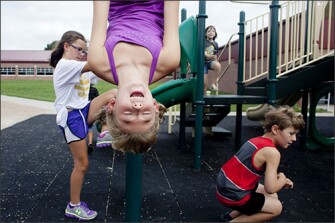CORRECTED
A report released this month finds that most states are lagging behind when it comes to meeting recommendations for physical education.
In fact, the found that only Oregon and the District of Columbia require the amount of weekly physical education time recommended by national experts at the elementary and middle school levels. [CORRECTION: (May 5) An earlier version of this story misstated the two jurisdictions that require the amount of weekly physical education time recommended by national experts at the elementary and middle school levels.]

and , a joint initiative of the American Heart Association and the Robert Wood Johnson Foundation, produced the report, which looks at the status of physical education across the country through a survey and analysis of state policies.
The authors recommend that elementary schools provide students with 150 minutes per week of instructional P.E., while middle and high schools provide 225 minutes per week.
But the report found that only 37 percent of the states require that a specific amount of time be spent in gym class in elementary school. That percentage drops to 29 percent in middle and high schools. And, 62 percent of states permit schools to allow students to substitute other activities for physical education.
“There are people who think marching band and R.O.T.C. is a substitute for physical education,” said ."There’s a misconception about physical education. A lot of people think it’s just about being active, but good physical education should have a strong educative component where we’re teaching kids new things. Just being active isn’t sufficient. We need to make sure that there’s learning that’s happening, too.”
Recess
The report also notes that only 16 percent of states require elementary schools to provide recess.
Lund says that’s unfortunate because unstructured play time serves a dual purpose for the youngest students, giving them a necessary brain break and allowing them to get more physical activity.
“Think about yourself sitting in front of a computer typing for three hours straight as hard as you can go without getting up and taking a break,” said Lund. “That’s what we expect our young children in school to do, and they’re just not wired that way.”
ESSA Connection
In addition to heading up SHAPE America, Lund holds a PhD in physical education teacher education and coordinates the graduate education program in health and physical education at Georgia State University. She says physical education fits in nicely with the Every Student Succeeds Act’s emphasis on soft skills in addition to academics. She says P.E. teaches the important skills of teamwork and cooperation.
“You can’t educate the child from the neck up,” said Lund. “It’s the whole body and the whole child. We know that stress can impact learning. We have a lot of students in elementary school who are suffering from stress. We know that physical education is a way to relieve the body of stress. Children, they’re built to play. They go on the playground, release some stress. They come back, and they’re ready to learn.”
See also:
Photo: Third grader Elyse Vinton hangs upside down during recess at Eastridge Elementary School in Lincoln, Neb., last year. (Andrew Dickinson for Education Week-File)